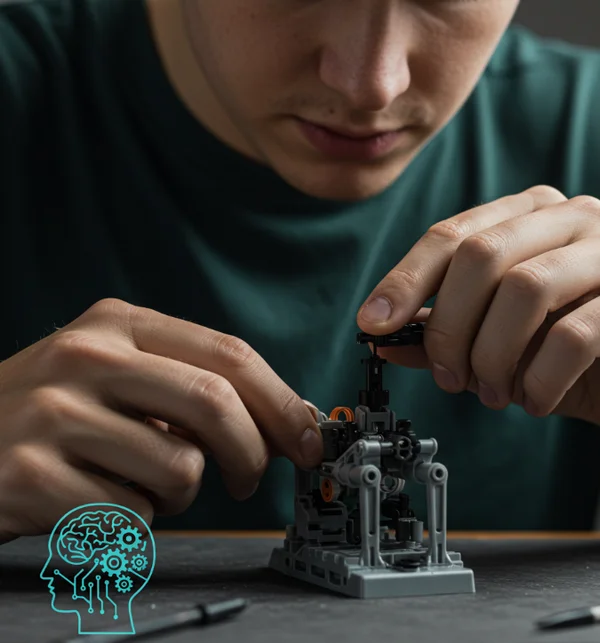Common Traits of Neurodivergence
Curious about what it means to be neurodivergent? Perhaps you've been exploring neurodivergent characteristics and wondering, "am I neurodivergent?" This article offers a guide for self-reflection neurodiversity, looking at some common traits often associated with neurodivergence. It is crucial to understand from the very beginning: this information is for self-reflection and understanding ONLY. It is NOT a diagnostic checklist, nor can it replace a professional evaluation by a qualified healthcare provider. Many people may recognize some of these traits in themselves to varying degrees. If you're looking for a starting point in your understanding, you can explore more about neurodivergent traits here.
Why This Is NOT a Diagnostic Checklist
Before we dive into specific traits, let's be exceptionally clear. Are you wondering how to know if you are neurodivergent? This article will not give you that answer definitively.
The Purpose of Self-Reflection vs. Professional Diagnosis
Self-reflection neurodiversity can be a valuable tool for personal growth and understanding. It can help you identify patterns in your experiences, thoughts, and behaviors. However, this is vastly different from a professional diagnosis. A diagnosis is a complex process undertaken by trained professionals (like psychologists, psychiatrists, or neurologists) involving comprehensive assessments, interviews, and often, consideration of developmental history. They are equipped to differentiate between traits, conditions, and other influencing factors.

Traits on a Spectrum: Understanding Nuance
Many traits exist on a spectrum, and their presence alone doesn't indicate neurodivergence. For example, everyone feels distracted sometimes, but the intensity, frequency, and impact of attention differences are what professionals assess. The signs of neurodivergence are not black and white; they involve a nuanced understanding of how various characteristics interrelate and impact an individual's life.
Avoiding Self-Labeling: The Dangers of Misinterpretation
While learning about neurodivergence can be empowering, misinterpreting information or self-labeling based on a list of traits can be misleading or even harmful. It might cause unnecessary anxiety or prevent someone from seeking appropriate support for unrelated issues. Always approach exploring neurodivergent characteristics with curiosity and a critical mind, remembering that lists like this are for general awareness.
Understanding Sensory Processing Differences
One common area associated with neurodivergence involves differences in sensory processing. What are signs you are Neurodivergent in this area?
Sensory Sensitivities (to light, sound, touch, etc.)
Many neurodivergent individuals experience heightened or dulled sensitivities to sensory input. This might mean bright lights feel overwhelming, certain sounds are physically uncomfortable, specific textures of clothing are intolerable, or conversely, a person might not notice pain or temperature extremes as readily as others. It's important to note that sensory sensitivities are not exclusive to neurodivergence and can be experienced by many for various reasons.
Sensory Seeking Behaviors
Conversely, some individuals may be sensory-seeking, meaning they crave intense sensory experiences. This could manifest as a love for loud music, spicy foods, constant movement, or deep pressure (like weighted blankets). Again, this is a human trait, but the pattern and intensity might be more pronounced for some neurodivergent people.

Impact on Daily Life
These sensory differences, whether sensitivities or seeking, can significantly impact daily life, influencing comfort levels in different environments, food preferences, and even social interactions. However, the way these neurodivergent traits manifest varies greatly from person to person.
Variations in Social Interaction and Communication Styles
Differences in social interaction and communication are often discussed when exploring neurodivergent characteristics.
Different Approaches to Social Cues and Norms
Neurodivergent individuals may process and respond to social cues differently. This could mean not intuitively picking up on unspoken social rules, having a different understanding of turn-taking in conversation, or finding eye contact uncomfortable or distracting. These are communication differences, not necessarily deficits.
Preference for Direct or Literal Communication
A preference for direct, literal, and unambiguous communication is common. Sarcasm, idioms, or implied meanings might be confusing or require more processing time. This isn't about a lack of understanding, but rather a different style of processing language.
Unique Ways of Connecting and Building Relationships
While societal norms for friendship might look a certain way, neurodivergent individuals often form deep and meaningful connections based on shared interests, mutual understanding, and authentic interaction, even if it doesn't fit a "typical" mold. These social interaction styles are valid and fulfilling.
Focus, Attention, and Executive Functioning Patterns
Patterns related to focus, attention, and executive function neurodivergent traits are another area of exploration.
Intense Focus (Hyperfocus) on Interests
Many neurodivergent individuals can experience "hyperfocus" – an intense, prolonged concentration on tasks or subjects they find engaging. This can be a significant strength, leading to deep knowledge and skill in areas of interest.

Challenges with Sustained Attention on Non-Preferred Tasks
Conversely, maintaining focus on tasks that are not intrinsically motivating or that are perceived as boring or overwhelming can be challenging. This isn't necessarily a lack of willpower but can be related to differences in how the brain regulates attention and motivation. These attention patterns are a key area of self-reflection neurodiversity.
Differences in Organization and Planning (Executive Functions)
Executive functions refer to a set of mental skills that include working memory, flexible thinking, and self-control. Neurodivergent individuals may experience differences in areas like organization, planning, initiating tasks, and time management.
Repetitive Behaviors and Specialized Interests (Stimming & Deep Dives)
What are signs you are Neurodivergent when it comes to behaviors and interests?
Understanding Stimming (Self-Stimulatory Behaviors)
Stimming neurodivergent behaviors, such as hand-flapping, rocking, spinning, or vocalizations, are often used for self-regulation. They can help manage sensory overload, reduce anxiety, express excitement, or aid concentration. Stimming is a natural human behavior, but it may be more pronounced or appear different in some neurodivergent individuals.
Passionate, In-Depth Engagement with Specific Interests
Having intense, special interests (sometimes called "deep dives" or "passions") is common. Individuals might develop encyclopedic knowledge about specific topics and find immense joy and fulfillment in exploring these interests deeply.

The Role of Routine and Predictability
A preference for routine and predictability can be important for some neurodivergent individuals. Knowing what to expect can reduce anxiety and make the world feel more manageable. Unexpected changes can sometimes be dysregulating.
Learning Style Preferences and Information Processing
How information is learned and processed can also show neurodivergent characteristics.
Unique Ways of Absorbing and Retaining Information
Neurodivergent individuals often have unique ways of learning best. Some might be strong visual learners, others kinesthetic (learning by doing), while some might excel with auditory information if presented in a specific way. Standardized teaching methods may not always align with these learning styles neurodivergent preferences.
Strengths in Specific Learning Modalities
While there might be challenges in some areas, there are often significant strengths in others. For example, a dyslexic individual might have exceptional spatial reasoning skills, or an autistic person might demonstrate incredible attention to detail.
Non-Linear Thinking Patterns
Thinking patterns may be more non-linear or associative, making connections that others might not immediately see. This can lead to creative problem-solving and innovative ideas, though it might also mean that explaining a thought process follows a less conventional path.
Emotional Experience and Regulation Differences
Emotional experiences can also be part of exploring neurodivergent characteristics.
Heightened Emotional Sensitivity or Intensity
Some neurodivergent individuals experience emotions very intensely, whether positive or negative. This heightened sensitivity can be a source of deep empathy but also make navigating emotionally charged situations more challenging.
Different Ways of Expressing and Processing Emotions
The outward expression of emotions, or the internal processing of them, might differ from neurotypical expectations. What one person experiences as a typical emotional response, another might experience or express quite differently.
Challenges with Emotional Regulation in Certain Contexts
Emotional regulation neurodivergent experiences can mean that managing and responding to intense emotions can sometimes be difficult, especially in overwhelming or stressful situations. This is an area where understanding and support can be crucial.
Many Traits are Widely Human
It's vital to reiterate: how do I know if I'm neurodivergent? This list is not the answer.
Recognizing that No Single Trait Defines Neurodivergence
No single trait on this list, or even a collection of them, automatically means someone is neurodivergent. Many of these traits are part of the broad spectrum of common human traits. Everyone has quirks, preferences, and ways of being that differ from others.
How Context and Intensity Matter
What often distinguishes neurodivergent experiences is the pattern, intensity, persistence, and impact of these traits on an individual’s daily life and functioning across different contexts. This is what professionals consider during an assessment.
The Importance of a Holistic View
Understanding oneself, or another person, requires a holistic view, not just a checklist of traits. It involves considering personal history, environment, strengths, challenges, and overall well-being.
Next Steps: If You Recognize These Traits
If you've read through this and find yourself resonating with many of these neurodivergent traits, or are concerned about them in yourself or someone else, here are some responsible next steps.
Journaling and Further Self-Reflection
Continue your self-reflection neurodiversity journey. Journaling about your experiences, how these traits manifest in your life, and their impact can be a helpful way to process your thoughts and gain clarity.
Talking to Trusted Individuals
If you feel comfortable, talking to a trusted friend, family member, or mentor about your observations can provide an outside perspective and emotional support.
When to Consider Seeking Professional Insight
If these traits significantly impact your daily life, well-being, relationships, or ability to achieve your goals, or if you are seeking accommodations or specific support, considering a professional consultation is a wise step. They can offer a comprehensive assessment and guidance.

Understanding Yourself Better
Exploring common traits associated with neurodivergence is about fostering deeper self-awareness and understanding, not about arriving at a self-diagnosis. Recognizing certain patterns can be validating and can open doors to learning more about yourself and how you navigate the world. Remember, human experience is incredibly diverse, and every individual is unique.
If exploring these traits has sparked further curiosity, learning about the role and limitations of online quizzes like the Neurodivergent Test or understanding when professional insight is valuable can be helpful next steps. Self-awareness is a journey, and online tools are merely one of many potential starting points for reflection.
Common Questions About Neurodivergent Traits
If I recognize some of these traits, does it mean I'm neurodivergent? Not necessarily. Many of these traits are common human experiences. Neurodivergence is typically characterized by a significant and persistent pattern of multiple traits that impact life in various ways. Only a qualified professional can determine if someone meets the criteria for a specific neurodivergent condition.
Can neurotypical people also have some of these traits? Absolutely! Most of these traits exist on a spectrum across the entire population. It's the clustering, intensity, and impact of these traits that are often considered in the context of neurodivergence.
What's the difference between a trait and a diagnosis? A trait is an individual characteristic or quality. A diagnosis is a formal identification of a condition made by a qualified healthcare professional based on established criteria, comprehensive assessment, and often, impact on functioning.
Should I use this list to self-diagnose? Emphatically, NO. This list is for informational and self-reflective purposes only. It is not a diagnostic tool and should not be used to self-diagnose or diagnose others. For diagnostic clarity, please consult a qualified professional.
What are the next steps if I'm concerned about these traits in myself or someone else? If you have concerns, the best next step is to seek information from reliable sources and consider consulting with a healthcare professional (like a doctor, psychologist, or psychiatrist) who can provide guidance or refer you for a comprehensive assessment. You can also explore further resources on our site to continue your learning.